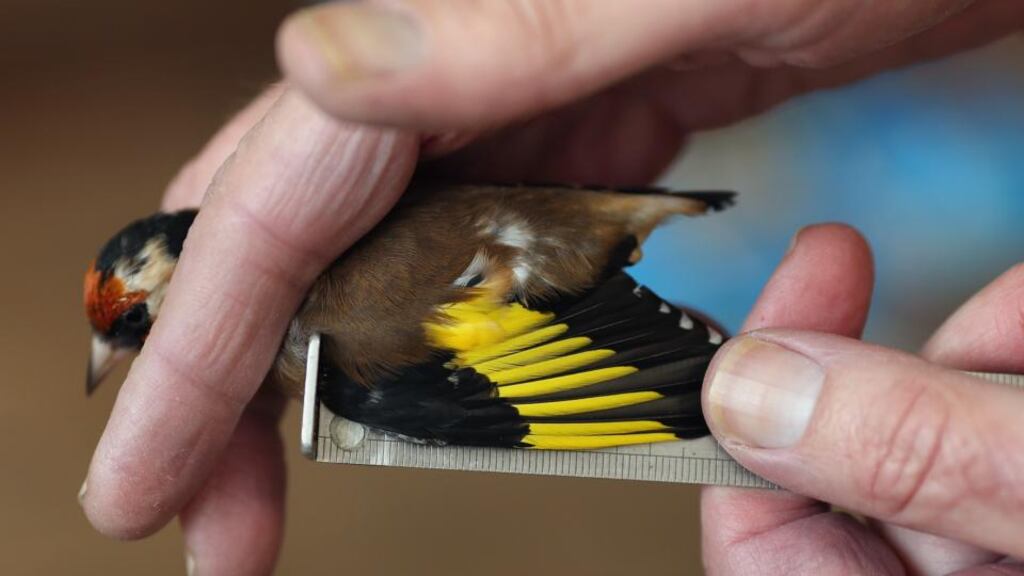It is a typically miserable winter afternoon. The ground is wet and cold. After five minutes standing on one spot my feet feel like lumps of dead meat. It is not an ideal moment to learn to love the great outdoors. Our host at this Garden Bird Day in east Co Wicklow, Eric Dempsey, is keenly aware of this, and he announces at least twice that we can go inside to a warm fire and hot drinks at any time. Out of 22 people attending, only three ever go back indoors, and then only briefly. Most remain outside for all of 90 very inclement minutes, and seem very happy to do so.
“How often do you get to be this close to a bird?” asks one of the participants when Dempsey repeats his reminder of home comforts nearby. “You can have hot coffee any day of the week.” She’s right. You can’t get any closer to a wild bird than when you are feeling its heartbeat against your fingers, as you prepare to release it after an expert has ringed it. But that’s how the day ends, not how it begins.
Dempsey is a formidable birder in the traditional sense, with a life list that includes ticks for 106 species of hummingbird alone. He is also the author of several books on Irish birds, as well as being a regular nature panellist on Mooney Goes Wild, on RTÉ Radio 1. You might expect him to be slightly intimidating for anyone who doesn't know a goldfinch from a greenfinch. But his courses mainly cater to a very general public, most of whom have limited ornithological knowledge when they arrive at his house. At this session only one participant has any birdwatching experience. But almost all have feeders in their gardens and want to learn more about the birds that visit them.

The morning’s indoor presentations focus on the identification and behaviour of common birds such as finches, tits and thrushes. Vivid close-up photographs show every detail of their plumage. We tend to be blind to the familiar, but Dempsey’s shot of a starling in good light shows how much we miss through this myopia: its iridescence is every bit as dazzling as a hummingbird’s.
Visitors are also introduced to less obvious birds, such as treecreepers and goldcrests, which are changing their behaviour and learning to take advantage of feeders.
We also find out how birds’ bills are matched to their food preferences. Finches have stout bills for cracking seeds, tits have beaks like drill bits for boring into nuts, and insect and worm eaters, such as thrushes, warblers and robins, have much finer bills.
This means you need to vary your food offerings to attract a wider variety of birds. You should also clean your feeders regularly. Greenfinch numbers have crashed recently because of a lethal disease apparently spread at unwashed seed dispensers.
Dempsey stresses the pleasure to be derived from learning about bird behaviour. An apparently one-legged perching robin has not suffered an injury, for example; it is retracting one leg into its fluffed-out feathers to conserve warmth in winter.
And our garden birds, even those we think of as entirely native, may be much more cosmopolitan than we realise. In a cold snap, that blackbird on your frosty lawn may have flown south from Stockholm.
The reason we know about such remarkable bird movements is largely due to a century’s hard work by citizen scientists dedicated to ringing. They attach uniquely coded leg bands to captured birds. If the ringed birds are later recaptured (or found dead), often years later, their location and condition can tell us a great deal.
The afternoon's workshop centres on the basics of this highly skilled craft. Over lunch a father-and-son team of licensed ringers, Declan and Patrick Manley, have set up mist nets around an impressive variety of feeders in the garden. Luckily the heavy rain has stopped, or they could not have proceeded: a bird left hanging in rain "like an upside-down umbrella", as Declan Manley puts it, would quickly be drenched, and at risk of a fatal chill.
Large flocks of finches, in particular, are constantly moving among the feeders. Soon 31 birds have flown into the nets, and tumbled into pocket traps within them. They include many goldfinches, some greenfinches and a few siskins and redpolls, as well as some blue tits. “It’s amazing to think that that little fellow might have been born in a Scandinavian forest,” Dempsey says as Patrick Manley nimbly extracts a redpoll from the net and puts it a cloth bag, where the dark seems to calm it.
In fact the birds remain remarkably docile throughout the ringing process, which includes weighing and measuring, adding steadily to a vast data bank for science. Details of plumage one could never see in the field, but which are essential for ageing or sexing similar individuals, are pointed out to a rapt audience.
Then each bird is briefly passed, with precise handling instructions, to a member of the group for release. Blue tits are the surprising exception to the docility rule. They have an uncanny knack of pecking sharply under the quick of your nail.
It’s hard not to wonder about the trauma caused to birds by ringing, but the scientific consensus is that the stress damage is minimal, and greatly outweighed by the conservation value of the information gathered. The released birds rejoin flocks immediately, and are soon back at the feeders where they had been trapped.
Afterwards, everyone agrees that they have had a fascinating, enjoyable day. Dempsey hopes that what he calls “these bird-awareness days” can have a long-term impact on people’s relationship with the natural world. “When you become more aware of something, you tend to take more responsibility for it,” he says.
birdsireland.com
















